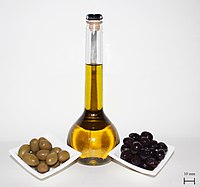
Photo from wikipedia
Extra virgin olive oil (EVOO), water, and a water/oil mixture (W/O) were used for frying, boiling and sautéeing Mediterranean vegetables (potato, pumpkin, tomato and eggplant). Differences in antioxidant capacity (AC)… Click to show full abstract
Extra virgin olive oil (EVOO), water, and a water/oil mixture (W/O) were used for frying, boiling and sautéeing Mediterranean vegetables (potato, pumpkin, tomato and eggplant). Differences in antioxidant capacity (AC) (2,2-diphenyl-1-picrylhydrazyl (DPPH), ferric iron (FRAP), 2,2-azinobis-(3-ethylbensothiazoline)-6-sulphonic acid (ABTS)), total phenolic content (TPC) and individual phenols (high-performance liquid chromatography (HPLC)) in unused and used EVOO and water were determined. The water used to boil tomatoes showed the highest TPC value, whilst the lowest was found in the EVOO from the W/O used for boiling potatoes. After processing, the concentrations of phenols exclusive to EVOO diminished to different extents. There was a greater transfer of phenols from the vegetable to the oil when eggplant, tomato and pumpkin were cooked. W/O boiling enriched the water for most of the phenols analysed, such as chlorogenic acid and phenols exclusive to EVOO. The values of AC decreased or were maintained when fresh oil was used to cook the vegetables (raw > frying > sautéing > boiling). The water fraction was enriched in 6-hydroxy-2,5,7,8–tetramethyl-chroman-2-carboxylic acid (Trolox) equivalents following boiling, though to a greater extent when EVOO was added. Phenolic content and AC of EVOO decreased after cooking Mediterranean diet vegetables. Further, water was enriched after the boiling processes, particularly when oil was included.
Journal Title: Antioxidants
Year Published: 2019
Link to full text (if available)
Share on Social Media: Sign Up to like & get
recommendations!